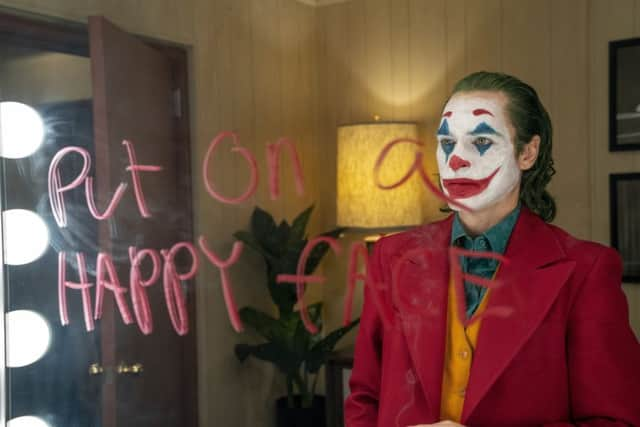Dr John J Marshall: Joke’s on experts who misdiagnose screen psychopath


The Joker is ostensibly a movie about decline into mental disorder (psychosis) and violence. Psychosis usually consists of strange or bizarre delusions and hallucinations, in this case, connected with his savage violence. Reviewers such as Drs Annabel Driscoll and Mina Husain in the Guardian are scathing about the movie’s perpetuation of stereotypes of people who suffer from psychosis, namely, the well-worn trope of “madness” and violence when we already know that people with psychosis are more often vulnerable than violent.
For those who have not seen the film, Arthur (played by Joaquin Phoenix) descends into homicide and mayhem, set amongst the relentless destitution, accumulating street garbage and giant rats. His performance is captivating.
Advertisement
Hide AdAdvertisement
Hide AdThe Joker erroneously blames his ferocious violence and chaos generation on mental illness: “What do you get when you get a mentally ill loner and a society that doesn’t care?” Other reviewers cite Arthur’s poverty, loneliness, and his “house of horrors” childhood abuse, as causing his violence. Some criticisms cite the over-focus on his “psychotic” symptoms to the detriment of a deprivation, but poverty looms large throughout this often bleak film. The problem is that this psychosis “analysis” is plain wrong. The Joker is not a person with psychosis, nor is he plagued by his disturbing past. He instead propels himself toward his grandiose destiny. Society needs to be prepared for the Jokers among us because he is a psychopath with a narcissistic personality. He uses his environment to his advantage, a juggernaut scything his way through his contextual troubles.
Clinical formulation is a way of trying to understand the drivers, in this case, of violence. So, what is the evidence for psychopathic and narcissistic personality disorders? In reality, he would not have descended into the depths so quickly but instead displayed serious chronic anti-sociality throughout his life. Plumbing the abyss of society so quickly makes for better drama. He may have suffered a brain injury during his childhood abuse which could have exacerbated his psychopathy and narcissism. Many have written that this brain injury, in turn, could have affected his incongruous laughter – cited as Pseudobulbar affect (or PBA). But PBA laughter is sudden and erratic, the Joker’s laugh is predictable. The key drivers for a clinical formulation are his narcissistic entitlement that he will be a great man and will profoundly influence society. Intricate and detailed fantasies abound in The Joker, but other mental health critics have astonishingly mistaken these imaginings for psychosis.
This is the real controversy of reflections on this film, taking the wrong diagnosis and setting up irrelevant straw man arguments about psychosis and violence. Coherent, logical, non-bizarre fantasies are not indicators of hallucinations or delusions. Despite Arthur’s pitiful stand-up comedy he is “ready for the big clubs”. He feels powerful when holding a firearm. He develops a taste for and a swagger of confidence, after killing. His low mood nihilism melts away.
The Joker’s emotions are shallow with short-lived rage and anger. His egocentricity shines through as he is fascinated by seeing himself on a TV show and is amused by his “fame”, while his mother lies dying. He is a grudge bearer and ruminates about revenge. He tells a psychiatric hospital clinic admin worker that he thought, killing three victims on a subway would bother him “but it really hasn’t”. His acts of killing are cold and callous, not hot-blooded. His idiosyncratic morality emerges when he says right and wrong are subjective.
The Joker constantly rehearses his grand entrance on to the world’s stage with his murderous Tai Chi movements. This is an organised mind that orchestrates great self-control, not a psychotic killer. The Joker, as an engine of chaos, is driven by his personality traits, whatever his environment. If critics of the movie are attacking the idea of “madness” and violence as promoting stigma among people with mental health problems, they could at least start by getting the diagnoses correct.
Dr John J Marshall is a consultant clinical and forensic psychologist